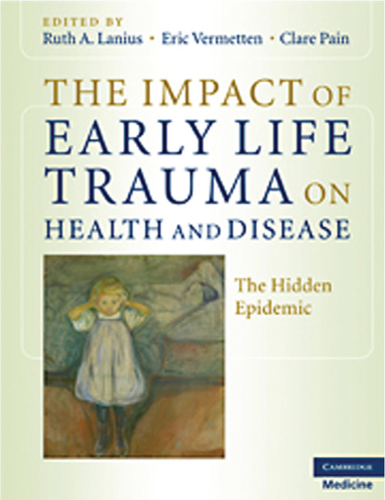Review of The impact of early life trauma on health and disease: the hidden epidemic, by Ruth A. Lanius, Eric Vermetten, & Clare Pain (eds.). Cambridge: Cambridge University Press, 2010. xvii + 315 pp. ISBN 978-0-52188-026-8. £55.00 Hardback.
This book is organised in six parts covering epidemiology and themes in childhood trauma, the effects of life trauma on physical and mental health, the psychobiological sequelae of early life trauma in children and adults, assessment of the impact of early life trauma including clinical science and societal effects, and clinical strategies to reduce the impact of trauma. There are 27 relatively short chapters, and six synopses by different authors designed to summarise and draw out the main themes in each part. The editors have assembled a stellar collection of contributors and the result is a rich and informative account of current knowledge concerning early life trauma and its effects.
The short chapters mean coverage of the field is broad including history, epidemiology, diagnosis, and controversies such as the recovered/false memory debate, biology, memory, assessment, and treatment implications. The various authors do a good job of directing readers to the most salient findings and issues and giving a sophisticated account of these, despite not having the space to provide the kind of coverage that would be found in an in-depth review. A good deal of attention is paid to the different kinds of childhood adversity, with welcome focus on neglect as well as abuse, and the reader is encouraged to think more deeply about the age when adversity occurs and about the risk and protective factors that serve to moderate outcome.
The greatest coverage is reserved for biological research, both animal and human, documenting the pathways by which early maltreatment may impact on later disease. Inevitably there is some overlap between the chapters, but the coverage includes diverse topics such as the neurotransmitter, neuroendocrine, and immune system responses to stress, cerebral lateralisation, structural and functional brain abnormalities including changes to gray and white matter volume, gene-environment interactions, and the neurocircuitry and neurochemistry of stress resilience. Taken together, these chapters provide an outstanding argument for the neurobiological mediation of the impact of early life trauma.
The final section is concerned with clinical strategies. Accounts of these can be found in greater detail elsewhere, but the value lies in systematically considering the implications of the earlier findings on emotional dysregulation for a variety of psychotherapeutic approaches. All in all, the book provides a compelling case for considering early childhood trauma as one of the most pervasive factors impacting disease, as a central aspect of much psychotherapy and as a top priority for health planners and policy makers. Future editions might consider devoting more space to the role of cognitive appraisals and a more in-depth account of the links between trauma and specific mental and physical disorders. The current edition should be on every clinician's bookshelf. It will prove an invaluable resource.
Chris R. Brewin
University College London, UK
